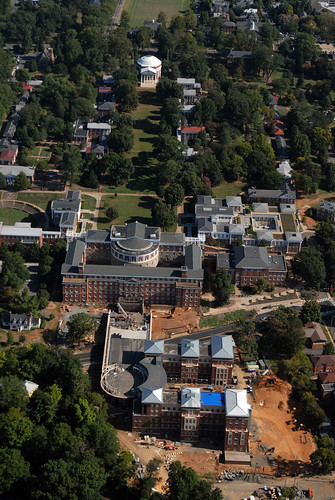Architectural Criticism from Traditional Architecture Compendium
A Compilation of Articles of and About Classical and Traditional Architecture
Posted by Dino Marcantonio
May 26, 2010
A student recently reminded me of the architectural hubbub of a few years ago at our alma mater, the University of Virginia. In September 2005, to kick off the semester, a large majority of the faculty members of the school of architecture signed "An Open Letter to the Board of Visitors, the University Administration, and the University Community" which criticized the university's periodic tendency to commission traditional architecture for buildings on grounds. It was penned in response to the university's firing of the staunchly modernist firm Polshek Partnership and the hiring of the slightly less staunchly modernist firm Moore Ruble Yudell to design the South Lawn Project.
There was a fierce reaction from the international community of traditional architects, culminating in a full page ad in the school paper, The Cavalier Daily, supporting the university's efforts to extend the principles embodied in The Lawn, the university's original buildings.

The University of Virginia Lawn, designed by Thomas Jefferson.

The University of Virginia's Hereford College,
by architects Tod Williams and Billie Tsien.
I summarize his points and offer rebuttals below.
1. The Traditionalist's argument that buildings should respect their context is a fallacy. In Venice, for example, the Renaissance interventions in the Gothic context were not contextual. Therefore, buildings don't have to be contextual to be good.
2. The argument for Classicism is based on the fallacy of Associationism, i.e., the meanings we associate with certain forms are constantly changing, therefore they provide an unsound foundation on which to form judgments. There are "deeper structures" to which we must appeal if we are to judge architecture properly. We see that deeper structure when we take away the "cow skulls" (i.e., the extraneous ornament) of Classicism.

I answer Ford's points as follows:
1. To argue that a Modernist building is to a traditional context what a Renaissance building is to a Gothic context is really to misunderstand Modernism, the Gothic, and the Renaissance. The Renaissance developed naturally out of the Middle Ages. In no serious way can it be argued that the Renaissance represents an approach at odds with the Gothic. In both periods the very same tradition is being tended to, but in the Renaissance period improved scholarship and economic power are brought to bear, as well as a change in taste and emphasis. Modernism, in stark contrast, seeks to end the Greco-Roman tradition, and it pursues the pipedream of an abstract architecture whose forms have no substantive meaning. It is impossible to build an abstraction.
2. Classicists do not argue for a superficial architecture, the smearing of molding sauce all over mediocre buildings without integrity. We hold, as suggested in my point one above, that forms have substantive meaning. Ford's drawing "Pages from Venetian Sketchbook" is perfect evidence for our case that the Modernists oversimplify classicism. I can't imagine many would believe Ford has revealed the reality behind the style with these sketches.
3. If Ford really believed he had revealed the reality behind the style, Ford would have to denounce the whole history of architecture. Greek moldings are not intrinsic to ancient stone construction--would the Parthenon be better without the intricacies of the Doric entablature to disguise the real load bearing going on underneath? Are the triglyphs "inauthentic"? Roman architecture is all revetment. When the Romans invented the arch (the high technology of the day) they didn't reveal the bricks that bore the real loads, they covered them up with archivolts.
4. Ford's point here seems to contradict his point regarding context. Was Venice, a pre-modern city, uniform or not? The classicists are not arguing for perfect uniformity in any case. We are arguing for intelligibility. Renaissance buildings in the Venetian context were and are eminently intelligible, just as modern Classicism in the context the University of Virginia makes perfect sense.
Ford's principles lead to Hereford College. And had Polshek not been fired and continued with the now almost complete South Lawn Project, we can be certain it would have turned out in a similar vein. Moore Ruble Yudell, however, are a more compromising firm, shall we say. The results are now coming into full view as the project nears completion.






No comments:
Post a Comment